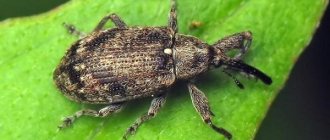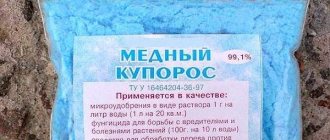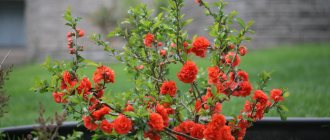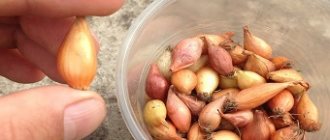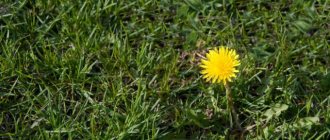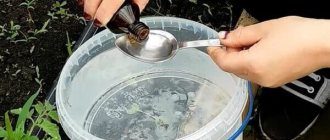Roses are demanding when it comes to growing conditions. They need constant careful care, as they are often exposed to diseases and pests. At the first signs of disease, it is necessary to take action, since the spread of diseases from sick to healthy plants occurs very quickly.
The Rosary may perish. The main prevention of spread is strict adherence to cultivation technology. Only in this case can you get beautiful and healthy buds.
How to treat roses with iron sulfate in the fall: proportions, advantages and disadvantages
The queen of flowers, the soda rose is a decoration for any front garden. Often, a luxurious bush needs help in the form of antifungal treatment, pest control and fertilizing. For this purpose, it is convenient to use a time-tested remedy called copper sulfate. Since roses are not resistant to various diseases, it is better to carry out treatment for prevention, constantly. An integrated approach, including treatment in autumn and winter, will eliminate the development of dangerous diseases that cause the death of shrubs.
Roses in spring: How to treat them against diseases and pests?
It is not for nothing that the rose is called the queen of flowers. Legends were made about it; the image of the flower is found in the symbolism of religions, esotericism, on coats of arms, etc. This is a flower of celebration, celebration, sacred rite. Rose oil and petals are used by women to preserve their beauty and youth. Delicious jam is made from rose petals. Flower growers know how much careful care a rose requires, but all efforts are rewarded a hundredfold. They begin to take care of roses in early spring. With the arrival of March, it’s time to ventilate shelters, prune, and treat roses from diseases and pests. Amateur florist Lyudmila Melnikova from Belgorod shares her personal experience of processing roses in spring:
Main characteristics and purpose
Iron plays a role in oxidative and energy metabolism, ensures the formation of chlorophyll in plants and takes part in the respiration process. Iron sulfate is recommended for use in the following soils:
- salted;
- carbonate;
- with acidity more than 7;
- calcined;
- with a high content of magnesium and phosphorus.
Copper sulfate is the only source of iron in high concentrations, which is well absorbed by the root system of roses. In gardening, 53% sulfate is used, which has the form of a green powder. The drug has a wide range of capabilities and is often used to provide additional nutrition.
The list of indications for use includes:
- prevention of fungal infections by irrigating the soil and above-ground parts of crops;
- treatment of fungal infections;
- prevention and treatment of non-infectious chlorosis;
- treatment of land and plants to prevent the vital activity of pests and larvae;
- disinfection of cracks and damage to the bark.
Treating roses in autumn with a solution of ferrous sulfate prevents the development of root rot and other damage to the plant over the winter. Spraying and processing of roses should be carried out in accordance with the proportions recommended for the crop. The use of concentrated formulations can lead to the cessation of growth and development of the root system for an indefinite period of time.
Condition of roses in autumn
When the weather is warm in the fall, the flowers are still actively blooming, and often all types of these plants tolerate light frosts. But with the onset of winter, they may die if no measures are taken. Therefore, flower growers need to perform the following care:
- stop watering so that it does not stimulate the growth of new shoots;
- do not loosen the soil, otherwise the soil will receive a lot of oxygen and will not be prepared for winter;
- remove buds and shoots;
- remove foliage from the lower branches of the plant and gradually move higher.
Purposes of application
Stimulation of plant growth appears some time after treatment, so this effect should be associated with the overall health of the rose bush. Immediately after using vitriol, the leaves of the plant may turn yellow and fall off. Treatment in spring leads to a slight deviation of the vegetation cycle - 1-2 weeks from the norm.
When feeding garden roses with copper sulfate in the fall, you need to remember that in addition to iron, the plant needs other microelements and nutritional components, so it is better to use complex formulations, and use copper sulfate for treatment against fungus and pests.
The solution is used in the fight against the following diseases:
- mycoses;
- powdery mildew;
- gray rot;
- black spot;
- anthracnose
Gardeners recommend watering the rose garden with a weakly concentrated solution before sending the plants for the winter. The soil contains spores of various fungi and other pathogens, which can become active after the shelter is constructed.
How to prepare roses for winter
The cold weather is approaching - it's time to think about covering your roses for the winter. Based on the experience of FORUMHOUSE users, we will tell you how to properly prepare different groups of roses for wintering, when to do this, and what material to choose for shelter.
Which roses need shelter?
Absolutely all groups of modern roses need shelter for the winter: hybrid tea roses, Floribunda roses, climbing roses, and even park roses obtained from decorative rose hips. Carelessness and laziness in breeding these beautiful flowers are unacceptable.
When to cover roses?
All roses begin to be covered for the winter when a small stable “minus” is established; especially heat-loving varieties - after the first frost.
HelgaFORUMHOUSE Consultant
I prune and cover at sub-zero temperatures (down to -5, last year - even in the snow), because I can afford to go to the dacha before there is stable snow.
How to treat roses before covering?
Roses can be sprayed with a 3% solution of iron sulfate or oxychome (according to the instructions). Be careful: exceeding the concentration may cause burns to the plant. In the spring, when opening, many people use a solution of copper sulfate.
What and how to spud?
The best spud for roses is a breathable composition: 50% earth, 50% sand. Peat is not suitable - it gets wet and cakes. In addition, the peat can freeze, and then its sharp edges damage the bark of the roses. Sawdust, hay and straw attract mice, so it is recommended to mix them with soil.
Many gardeners, having tried different options for hilling roses, abandon it altogether due to the threat of damping off.
HelgaFORUMHOUSE Consultant
Now I only plant “first-year” roses in my garden (three-year-olds). I hill up with a mixture of earth and sand in equal parts. It is lighter and dries faster, preventing the roses in its thickness from getting wet.
Many consider lutrasteel, well pressed on the sides, to be quite sufficient protection. Know-how of FORUMHOUSE users: lutrasteel is not sprinkled with earth and is not pressed with stones, but is pinned with bamboo kebab sticks. Unlike sticks made of ordinary wood, these do not rot and remain firmly in the ground until spring.
How to cover different types of roses?
The varietal and species affiliation of a rose affects its winter hardiness, and therefore, the way it overwinters.
Hybrid tea roses
These are the most pampered roses: they easily freeze and dry out in the spring from moisture that can accumulate under the shelter. So this group of roses needs some extra help. Before sheltering, they are cut to 40-45 cm, all diseased and immature shoots are removed.
That is, hybrid tea roses do not need to be laid, they are simply pruned to the level of the shelter. It has been noticed: the lower the hybrid tea rose is pruned, the better it will bloom next summer.
Ideally, hybrid teas are covered with a frame onto which one or another material is “put on.” Thus, since 2000, FORUMHOUSE consultant Lobelia has been covering grafted hybrid tea bushes and self-rooted cuttings, which have become bushes during this time, with a roofing felt tunnel. Ruberoid is laid on the arches, the material is pressed down from the sides with slate. The southern end of the tunnel remains open.
LobeliaForumHouse Consultant
Of course, there is a lot of fuss, and the view is still the same, but everyone is alive and well, and this spring we were together with them again!
climbing roses
Climbing roses are covered along the entire length of the shoots - this measure ensures sustainable flowering for the next year. The lashes of young bushes are removed from the trellises in advance before they lose their flexibility. It happens that a rose grows three meters over the years - such long plants are “landed” for a long time and gradually: they are tied with a string, the string is tied to a peg driven into the ground (a barbecue skewer is perfect) and once a week they are pulled a little to the ground. For normal wintering, a half-meter bend of the rose above the ground is enough. The shoots are pinned with arcs, which can be made from pieces of wire with a diameter of 4 mm and a length of approximately 60 cm.
Brief instructions for bending lashes from the user FORUMHOUSE sw111
A climbing rose is not placed on the ground, but, for example, on a layer of spruce branches. Instead of spruce branches, you can use, for example, autumn cut raspberries, but here it is important that the shoots do not come into contact with the green mass: non-woven material is spread on top of the raspberries. It is recommended to cover with Lutrasteel, preferably 60-m. By the onset of stable frosts of -5-7 degrees, the rose should be laid and closed.
Laying overgrown climbing roses for the winter is labor-intensive and troublesome, so many simply cover the entire bush, along with a trellis, burlap, or wrap it in thick paper or covering material, or something else suitable.
Olga F.
I wrap the climbing roses STANDING in cardboard boxes and put sugar bags on top of them. Spud up. To prevent them from falling, I tie them to a support (they mostly grow near the fence).
Floribunda roses
“Floribundas” are more resistant to climatic conditions than tea and park roses, however, they also need comfortable conditions for overwintering. Let's see how the recognized authority in rose growing at FORUMHOUSE Helga does it.
HelgaFORUMHOUSE Consultant
You cut off everything that blooms, cut out everything unnecessary (thin branches on which flowering will be poor, new but not woody shoots). Tilt the rose under cover. Fix it in a horizontal position. The spud should be breathable. Cover (not wrap) all this stuff with lutrasil. A double layer of 60 may be sufficient.
Park roses
Park roses are the most winter-hardy, but they also need shelter.
HelgaFORUMHOUSE Consultant
We do not have cultivated roses that do not need shelter. NO. These are flowers not of our climate. Only various “rose hips” can afford to spend the winter uncovered. This does not apply to “Canadians” either.
The easiest way to prepare a park rose for wintering is to simply bend it down, “pin” it to the ground and cover it with something for safety – spruce branches, pieces of roofing material, etc. Without shelter, many shoots of park roses will probably be frozen.
The method of covering depends not only on the type of rose, but also on what seems necessary to its owner. Some people think that roses should definitely be earthed up, others have long given up earthing up. Some people necessarily treat roses on the eve of wintering, while others think that summer treatments are quite enough. Some people remove leaves, others consider it extra work.
As for the advisability of air-dry shelter, most FORUMHOUSE rose growers agree that it is better for “seasonal” summer residents not to use it. VSU can be used by those who live next to their roses, or by those who are guaranteed to be able to get to their dacha in early spring. If you are late with the opening, you can lose the roses.
“Seasonal” summer residents are better off not using it.
Finally, we invite you to get acquainted with personal experiences that users of our portal consider successful.
This is how VEP covers roses:
- He removes the leaves from the roses, trims the bushes by a third and ties them up.
- Sprinkles the roses on about half the bush: first with sand, then with earth.
- Monitors the temperature. -5- -8 degrees are not harmful to sprinkled roses, but the exposed grafting point may be damaged.
- When the temperature drops persistently, VEP covers the sprinkled roses with lutrastil. A cucumber mesh is pulled over the arches, with agrofibre on top. The edges of the lutrasteel are pressed to the ground, but leave holes for air exchange.
- When the temperature drops below -12-15 degrees, the VEP closes these holes and hopes that the shelter will be covered with a blanket of snow.
Olga F. in her Volgograd, whose climate is characterized by low humidity, little snow, sudden temperature changes and strong winds, covers roses as follows: on the first weekend she trims the bushes and covers them with sapropel (each bush takes from half to a full bucket). Loose vegetation, for example, cut asters, is thrown on top. Before the ground freezes, he makes arches 50-80 cm high from plastic pipes. The arches are placed every 70-80 cm.
Olga throws in loose vegetation for insurance: if the cover does bend, it will not fall directly on the roses. The air gap will remain, albeit minimal.
Lutrasteel protects roses from spring sunburn, and polyethylene provides dry cover
Next weekend (or, depending on the weather, later), he covers the arches with lutrasteel, and on top with polyethylene. Along the perimeter, the shelter is pressed to the ground. Olga covers small roses not with arcs, but with plastic boxes, with lutrasteel or polyethylene on top.
Olga believes that it is correct to use these two materials at once for shelter: lutrasteel protects roses from spring sunburn, and polyethylene provides dry shelter, the main thing is that the air gap is really large.
Over the four winters in which Olga practiced this method of covering, about five of her hundred roses disappeared. And one of them was stupid: Olga opened a small cutting too early, and it burned in the sun.
Olga F FORUMHOUSE user
I learned the method of hiding from a neighbor. She is my famous rose grower!
It is very important in the spring to overpower yourself, and not to rush to take off the lutrastil, even though “these parachutes are like a bone in the throat.” Untimely opening of bushes in the spring can lead to burns from the bright spring sun. At the same time, if the spud is not removed, the roses may dry out. Experts advise that at the first warmth of spring, open the roses, remove the bushes, perhaps spray the bushes with a weak solution of copper sulfate and cover them again with spruce branches or lutrastil. If the gardener uses an APU, then it will be enough to open the ends for ventilation or remove the waterproof part of the shelter (in the case of Olga F., this is polyethylene).
Our portal discusses in detail the preparation of roses for winter. We also recommend you an article on how to care for roses and a video that talks about the preparatory work that needs to be done with the roses before they are covered.
Features of the drug
Treatment of roses with vitriol can only be carried out in the fall. Using the drug in spring is dangerous for the plant because it provokes the formation of brown spots on the leaves. They do not harm the bush itself, but the leaves cannot be restored. Autumn treatment is carried out after falling or preliminary removal of green mass. Before wintering, you need to treat the bush for preventive purposes with a solution of 3% concentration, that is, dissolving 30 g of the drug in 1 liter of water. High concentrations can cause burns to young shoots of shrubs, and low concentrations are not effective in combating mycoses.
In emergency cases, solutions with a concentration of 1% can be used after the leaves and buds of the rose bloom. The buds must be protected from liquid, the solution is carefully distributed over the leaves using a spray bottle. Treatment is carried out at intervals of 10 days, twice. The activity of the product decreases after rain because the product is washed off the leaves.
When preparing a rose garden for winter, you need to remember that covering the flowers until they dry is prohibited. The solution needs 2 days to work, without precipitation. Fallen leaves must be removed and burned. It is not allowed to use vitriol in a mixture with other fungicides or lime.
Usage
The treatment process and preventive treatment of roses occurs precisely with the help of iron sulfate. The most noticeable effect is in the fight against black spot disease. Works great and does everything it claims to do during the fall season before covering the roses. It contains fifty-three percent of the active ingredients.
Before use, be sure to make a three percent working sample. To make it, you need thirty grams of iron sulfate, which are thoroughly dissolved in a small amount of water. The prepared preparation must be raised with clean water to a volume equal to five liters. Usually the drug is used on roses about ten liters per hundred square meters. It is recommended to use the solution immediately.
Purchase a spray bottle to use with the resulting solution. It is worth using a solution of iron sulfate only on days without winds, any precipitation and in the evening. Keep an eye on the weather forecast, since after applying a preparation containing iron sulfate, it is necessary not to wet the plant for about four to five hours. The solution will begin to work one hundred and twenty minutes after application.
The drug is effective for one to two weeks.
The use of the drug in the autumn season stops the processes of infection of various diseases in the winter season. Before applying the solution, you should destroy all foliage from the plant. Do not allow air into the root system while the solution is being treated.
It's worth digging up the ground. This will help stop the process of contamination of the land. The advantage of this disinfection method is the absence of diseases and parasites for two years. The disadvantages include numerous burns of foliage.
To combat the disease “powdery mildew”, it is worth applying a product containing copper sulfate. If processed in the spring season, diseases will not arise. It is worth repeating this procedure weekly (after the same number of days have passed). Apply treatment before flowering. The use of a drug containing copper sulfate in the autumn should be in the following proportions: mix twenty grams of copper sulfate with nine liters of water with a small amount of laundry soap.
Advantages: the drug is very cheap, processing roses is easy to use and brings quick positive results.
Disadvantages: numerous burns of foliage, the solution is poisonous.
This drug should be used as a preventive procedure.
Advantages and disadvantages
The antifungal agent has advantages:
- low price;
- high damaging ability against fungi;
- non-toxic to humans;
- does not change the qualities of the soil mixture;
- stimulates crop growth and increases immunity to diseases;
- acts externally and does not penetrate cells.
- low efficiency as an insecticide;
- restrictions on the period of use (before bud break and after leaf fall);
- destruction of the green mass of the plant;
- difficult to choose concentrations;
- It is washed off after precipitation and stops working.
Preparation of working solution
To effectively combat fungal infections, rose bushes are treated with a 3% solution. You need to spray the bush thoroughly. The manipulation is carried out on dry days, because the solution must dry on the leaves. If it rains, you need to repeat the treatment.
If the treatment was not carried out in the autumn, it is carried out in the spring. For this I use a 1% solution. To prepare a working solution with a concentration of 3%, dissolve 30 grams in 10 liters of water. drug, to obtain 1% - 10 g. The dry mixture is poured into cold, clean water and the mixture is vigorously stirred until completely dissolved. Do not use the product together with other fungicides. The finished composition is used immediately; upon contact with air, it loses its activity.
Spraying during the growing season
Fungal infection enters roses from the outside. Moreover, this can happen at any time. For example, powdery mildew spores are carried not only by insects, but even by the wind. In such a situation, roses have to be treated with copper sulfate additionally, for example, in the summer.
If signs of the disease are detected, you should immediately prepare an aqueous solution of copper sulfate with a concentration of 0.5%, no more. The bushes are sprayed three times, but with a mandatory interval of 10 days.
Be sure to do this on clear days; rain will ruin all your efforts.
In order for the drug to remain longer on the surface of the leaves and branches of the rose, experienced gardeners dissolve 100 grams of laundry soap in ten liters of solution. This ensures good adhesion of the drug.
By the way, people often ask how much copper sulfate is contained in 1 tablespoon. This is important to maintain proportions. Experienced gardeners know this, as they write about in reviews - 25 grams. But a teaspoon holds about 10 grams.
How to treat the above-ground part and soil
Treatment should be carried out by spraying in the fall, but since rose disease occurs regardless of the season, iron sulfate is used in small concentrations during the growing season.
Treatment of shoots in spring and summer is carried out according to the following scheme:
- use a solution with a concentration of 1%;
- it is distributed over the leaves and shoots of the plant using a spray bottle;
- rose flowers are removed before processing;
- fallen leaves are collected and burned;
- The treatment is repeated 3 times every 10 days.
Treatment scheme in autumn:
- carry out autumn pruning;
- remove fallen leaves;
- prepare a solution of 3% concentration and spray the rose with it;
- You can cover the bush on the 3rd day after the manipulation, but no later than on the 14th day.
You can water the soil with vitriol before wintering the plant, because fungal spores can form from the soil. Be sure to spill the prepared mulch with the mixture.
Autumn processing of roses
Often, in order to protect roses from diseases, just treating them with an aqueous solution of vitriol is enough. This is done in late autumn just before covering the bushes for the winter.
For autumn treatment you need to prepare a 3% solution. This is a high concentration, but taking into account the fact that there are no leaves on the stems at this time, this dosage is optimal.
Ask and receive useful advice from professional gardeners and experienced summer residents.>>
Before spraying, collect fallen leaves under the bushes and burn them. Fungal spores can overwinter in them.
Carry out the treatment on a dry day, sprinkle each branch generously with the drug solution. To do this, use a spray bottle, because using a broom you will not get the desired effect from the treatment. Moisten all stems with copper sulfate from bottom to top.
It is very important to wait until all the branches are completely dry. Only after this begin to cover the roses for the winter. Wet bushes cannot be covered.
Features of working with the solution
Experienced gardeners recommend treating with a fungicide after the leaves fall. If the plant was not sprayed in the fall, this should be done in the spring, but before growth begins. The purposes for using the product are different, as are the methods of application. A solution of vitriol is used to spill the soil and spray the above-ground part.
For fungal infection
Fungal infections often get into the rose garden with new, acquired varieties, so before planting new bushes in the garden, they need to be inspected for the presence of fungi and pests.
The list of common fungal infections of roses includes:
- spheroteka;
- peronosporosis;
- gray rot;
- rust;
- infectious burn;
- septoria.
Iron sulfate is used for the prevention and treatment of these diseases in seedlings. Use a 3% solution, which is applied to the shoots using a sprayer. The leaf mass will be lost. The period of operation of the product is 2 weeks.
Insect control
To treat pests, the working solution is used in the fall, before covering the rose garden for the winter. Before irrigating the above-ground part of the plant, sanitary pruning is carried out and all fallen leaves and removed stems are removed from the front garden. Before spraying, you need to water the soil and feed the rose before wintering.
Additional food
Treating a rose garden with vitriol in the fall can be done not only for the purpose of healing, but also for fertilization. To do this, dissolve 30 g of the composition in 3 liters of soft water. The drug is used at the rate of 10 liters of working solution per 100 square meters. Watering is carried out in dry, windless weather. This technique is not used in summer.
Prevention procedures and treatment methods
Diseases that are not infectious appear as a result of a lack or excessive amount of microelements. The positive result of the treatment process directly depends on the correct conclusion about what kind of disease the flower was infected with. Based on the type of disease, it is worth choosing a protective drug.
Each of the representatives of a huge number of varieties of the disease has its own specific qualities, knowing which it is possible to immediately take measures to carry out the correct treatment process. A positive result depends not only on a careful and correct choice of means and method, but also on an immediate reaction, because, having been transmitted to other varieties of herbaceous crops, it is unlikely to be possible to keep them healthy.
The most famous and common diseases are common rust and fungal disease. For the procedure for the prevention and treatment of these types of diseases, it is worth purchasing vitriol in a store with a garden theme or in an ordinary supermarket in the household chemicals department. You can purchase both copper sulfate and iron sulfate.
It is the most used and effective fungicide with a huge number of applications, for example, it is used to stop the growth of fungal diseases.
Comparison with other fungicides
The comparative table shows popular analogues of vitriol:
| A drug | Description |
| Ridomil gold | A product that is safe for roses and not only has a contact effect, but also penetrates the stem. The product is not washed off after rain, therefore it is more effective than kuparos due to its long-lasting action. |
| Oksikhom | Used to treat rose gardens against mycoses at any time of the year. There are no strict contraindications for use during the flowering period. |
| Abiga peak | It is washed off with water, so it stops working after rain. Does not harm green mass. |
| Bordeaux mixture | Widely used in gardening, but preparing a working mixture is difficult. |
Answers to questions about use
There are some peculiarities in using copper sulfate in gardening. The rules that apply to garden crops do not apply to roses. For example, to treat fruit-bearing trees, 5% solutions are used in the spring, while such a concentration will simply kill the rose bush.
A solution of even small concentrations is harmful to the soft tissues of the plant, immature shoots and leaf mass, therefore blackening after treatment is natural. We need to wait for spring. And then remove the cover and see what happens to the bush. If the roses have received a chemical burn, prune them down to the soft tissues, and treat the sections with crushed activated carbon. You can’t expect rapid growth and flowering in the coming season; the main task is to save the weakened bush, so you need to stop using fertilizers.
What is copper sulfate
A water-soluble, colorless, odorless chemical substance, copper sulfate, has disinfectant properties, is widely used in medicine as an antiseptic, and in plant growing as a fungicide. Effectively fights fungal diseases of fruit trees and rose bushes. The traditional name is copper sulfate. When interacting with enzymes of fungi and bacteria, it causes irreversible changes in the latter.
Application in horticulture
Copper sulfate is used in the garden in the fall to protect fruit trees, shrubs, flowers and soil from a number of diseases caused by the activity of microorganisms and insects. Experienced gardeners recommend autumn spraying with a solution of the drug for preventive purposes and to destroy colonies already existing on plants:
Plants growing in acidic sandy or peaty soils receive too little copper. They experience insufficient growth, wilting of leaves, and with a severe lack of copper, ears and seeds do not form. In this case, treating the soil with copper sulfate in the fall is a fertilizing procedure. If a fungicide was used as a fertilizer in spring or summer, there is a risk of oversaturation of the soil with copper.
Plant nutrition
To keep flowers healthy and beautiful, they need to be fed.
Advice!
According to flower growers, the last feeding of roses should be carried out before the beginning of October.
As a rule, these flowers are fed several times: at the end of summer and at the beginning of autumn. The main thing is that the fertilizers contain potassium; it reduces the freezing point in plant cells and improves their resistance to temperature changes.
Another important element in feeding is phosphorus. This element allows the plant to ripen quickly.
Calcium makes the plant strong and prevents various diseases. This element also removes excess liquid from plant cells.
To begin with, the plants are fed with fertilizers containing potassium and phosphorus. You can buy them at a gardening store, a ready-made mixture, and dissolve it in water. Then spray the plant. At the time of the second feeding, you can use wood ash, which contains a high content of potassium and calcium.
Interesting!
During rainy autumn, you should use granular fertilizers, which, when dissolved, nourish the bush.
How to treat a greenhouse with copper sulfate in the fall
If you treat the greenhouse with copper sulfate before winter, then by spring there will be no harmful microorganisms in it. The preparation must be applied not only to the soil, but also to the entire greenhouse structure. The inner surface must first be treated with soapy water, and areas where mold is found must be cleaned with sandpaper. The greenhouse should be processed as follows:
- remove plant debris from the greenhouse;
- remove dirt from the greenhouse covering, wash with soapy water;
- prepare a solution with a concentration of 50-100 g of copper sulfate per 10 liters of water;
- wash the entire greenhouse cover with the mixture;
- Using a watering can, pour the solution onto the soil inside the greenhouse.
Types of spring spraying (video)
Bordeaux mixture is an effective protective fungicide. Preparing Bordeaux suspension is a labor-intensive process. It is necessary to provide special utensils, protective clothing, glasses, a respirator and observe safety precautions when working with quicklime and copper sulfate powder.
In order not to lose the material, be sure to save it to your social network VKontakte, Odnoklassniki, Facebook by simply clicking on the button below:
| 21528 | 3 | Print Click Print or CTRL+P to print the page |


